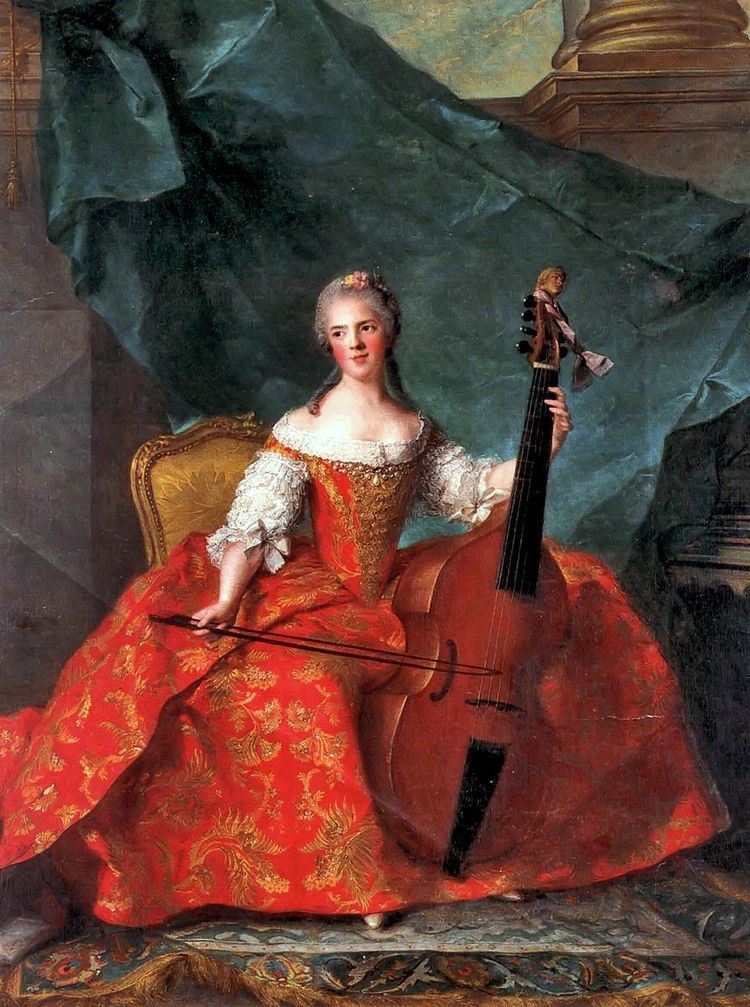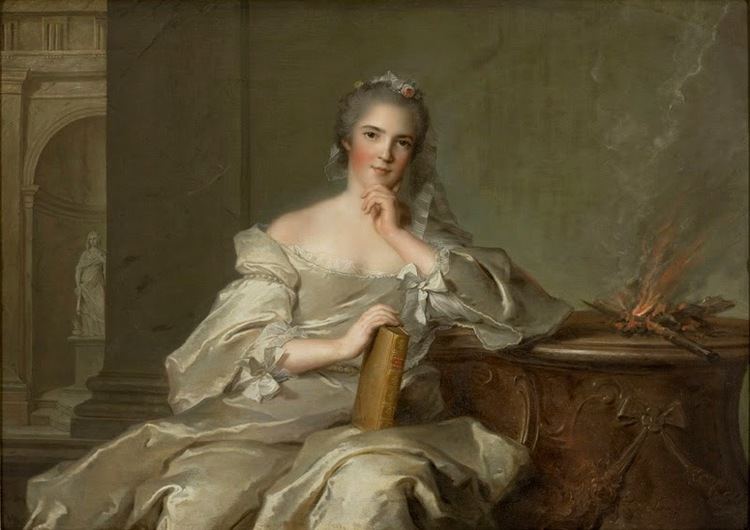House Bourbon Name Princess of Religion Roman Catholicism | Mother Marie Leszczynska Father Louis XV of France | |
 | ||
Born 14 August 1727
Palace of Versailles, France ( 1727-08-14 ) Died 10 February 1752(1752-02-10) (aged 24)
Palace of Versailles, France Burial Eventually Basilica of Saint Denis, France | ||
Princess henriette of france
Anne Henriette of France(14 August 1727 – 10 February 1752) was a French princess, the twin of Louise Élisabeth of France, and the second child of King Louis XV of France and queen consort Marie Leszczyńska.
Contents

Early life
The twins were born at the Palace of Versailles on 14 August 1727. While the birth of the twins were considered a political disappointment, because the Salic Law disqualified them as heirs to the throne and the succession was thus still unsolved after their birth, their father, the King was delighted, and commented that after all talk of him not being able to be a father, he was now the father of two. Henriette was named after her paternal great-great grandmother Henrietta, Duchess of Orleans, with Louis Henri, Duke of Bourbon and Louise Anne de Bourbon as her godparents. As the legitimate daughter of the king, she was a fille de France, but as the younger of the twins, she was referred as Madame Seconde; as an adult, she became known as Madame Henriette, or only Madame, as the eldest daughter of the king present in Versailles after the marriage of her sister.
The eldest children of Louis XV, the twins Élisabeth and Henriette, Marie-Louise, Adélaïde and their brother, the Dauphin of France, were raised in Versailles under the supervision of the Governess of the Children of France, Marie Isabelle de Rohan, duchesse de Tallard, while their younger siblings, Victoire, Sophie, Therese and Louise, were sent to be raised at the Abbey of Fontevraud in June 1738.
In 1739, her twin moved to Spain to marry the Infante Philip, a younger son of King Philip V. Henriette was reportedly despondent about being separated from her twin.
Adult life
Henriette was considered to be a beauty and prettier than her elder twin. She was described as gentle and melancholic to her temperament, reserved but intensely loyal, and gifted in music, and she studied the viola da gamba with Jean-Baptiste Forqueray. She was evidently the favorite child of her father, and it was said that she had no enemies at court.
Henriette reportedly fell mutually in love with her cousin, Louis Philippe, duc de Chartres, the heir to the House of Orléans, and wished to marry him. The King initially liked the idea, but changed his mind, not wanting the house of Orleans too close to the throne, and the plans were discontinued in 1743. Henriette never married, was never engaged, and no marriage negotiations was ever made for her.
One of the reasons as to why her younger sisters were sent to be raised away from Versailles, was the high expense of the royal children, who were allowed to participate in court life as well as arrange their own festivities already as children; and those kept at court, among them Henriette, evidently attended the festivities and representational life already from the age of twelve. From at least 1744, she and her sister Adelaide accompanied her father to the Opera in Paris, and hunted with him five days a week from the beginning of 1746 onward.
Her twin Élisabeth, who was described as ambitious, was not satisfied as the spouse of a prince without a throne; she kept in contact with the French court through correspondence, and had already by 1740 established a net of contacts at the French court to assist her in her ambition to obtain an independent power position for herself and her spouse, "worthy of the birth of both", and Henriette was one of her most fervent contacts in this issue. Otherwise regarded as habitually apathetic of politics, Henriette was reportedly passionately devoted to work for the political ambition of her twin, as did her younger sister Adelaide and her sister-in-law Infanta Maria Teresa Rafaela of Spain; the powerful Noailles and Maurepas allied with the queen to achieve the same, and the French ambassador at Madrid, Monseigneur Vaurdal, Archbishop of Rheims.
Henriette, as well as her siblings, disliked their father's extramarital liaisons because they caused their father to neglect their mother, and their discontent with their father's adultery was directed toward his mistresses, notably Madame de Pompadour, who from 1745 onward was their father's official mistress at court and influential upon the affairs of state. With her brother, the Dauphin Louis, and her sister, Madame Adélaïde, she called the powerful mistress, Maman Putain ("Mother Whore"). When Louise Élisabeth returned from Parma for a year-long visit to Versailles in 1748, she and Madame de Pompadour became close friends, which led to a temporary estrangement between the sisters.
In 1747, her brother Louis was forced to marry Maria Josepha of Saxony, Dauphine of France, against his will shortly after the death of his beloved first spouse, Maria Teresa Rafaela, in childbirth. This caused Louis to initially be hostile toward Maria Josepha, even more so when his only child with the Spanish Infanta died at the age of two, but she eventually managed to win his affection, upon the advice of Henriette.
Death
Henriette died of smallpox in 1752 at the age of twenty-four. In February of that year, she had felt somewhat unwell and tired, but when the king asked her to accompany him on a sledge ride, she gave no signs of her discomfort, and accepted the invitation anyway. She was badly affected by the chilly weather, and died after just three days of illness. Her family was described as being in a "state of stupefaction over the rapidity of the illness."
Louis XV reacted with "violent" despair upon her death and gave order of the highest honors around her funeral; in order the enhance the public mourning, her remains were placed at the Tuileries instead of Versailles prior to the funeral, dressed in one of her finest dresses and made up so to appear alive. The public funeral reception was however not to the king's taste, as the public "drank, laughed and amused themselves", which was taken as a sign of the diminishing reputation of the monarchy. At the time, the public interperted the death of Henriette as a sign of divine disapproval of the king's lifestyle.
Her heart was interred in the Abbey of Val-de-Grace, while her remains was buried at the Basilica of Saint Denis, along with her sister Elisabeth. Her tomb, like other royal tombs at Saint-Denis, was destroyed during the French Revolution.
Madame Campan later wrote about her: "Madame Henriette, twin sister of the Duchess of Parma, was much regretted, for she had considerable influence over the King’s mind, and it was remarked that if she had lived she would have been assiduous in finding him amusements in the bosom of his family, would have followed him in his short excursions, and would have done the honours of the ‘petits soupers’ which he was so fond of giving in his private apartments."
